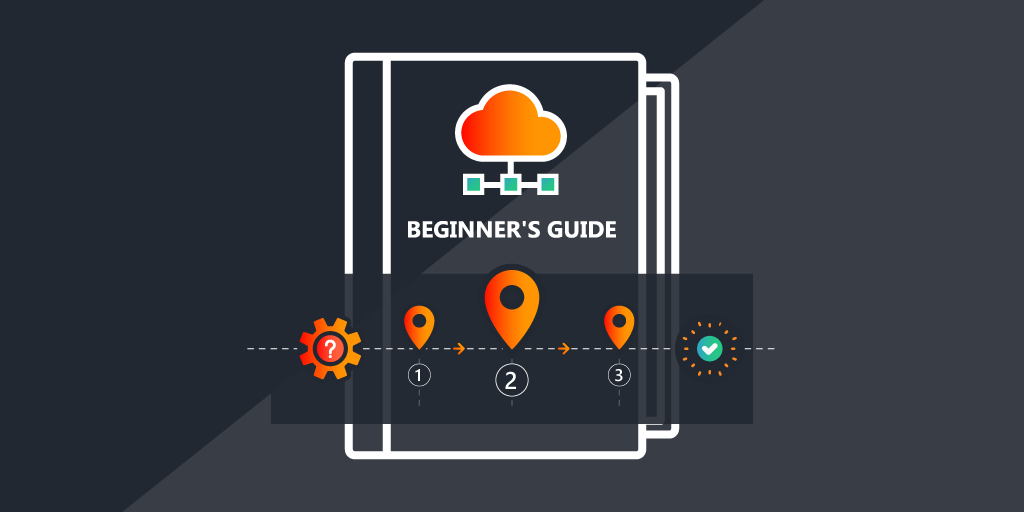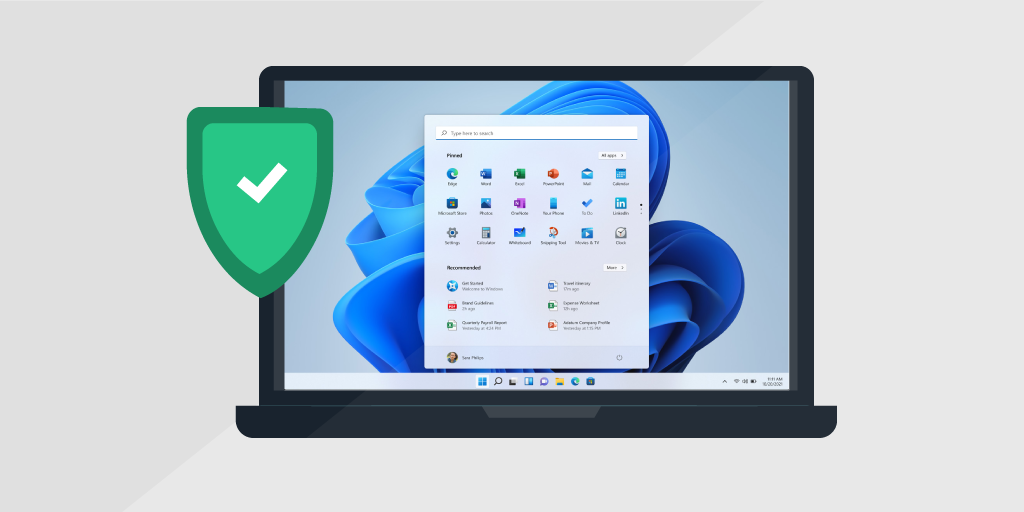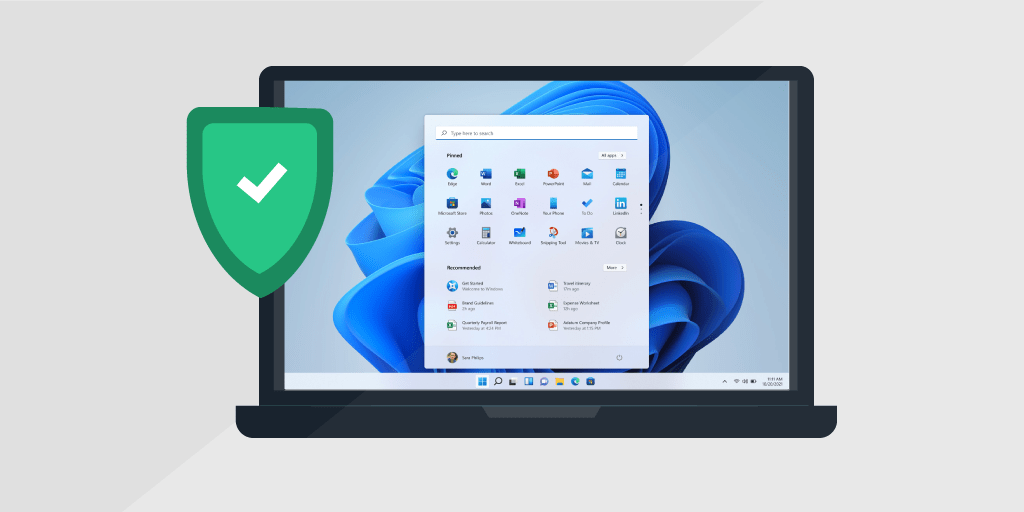
It has been 2 years since Microsoft first released Windows 11. IT teams managing IT Assets in large enterprises are still working to roll out the new OS. They will need a quick and cost-effective Windows 11 readiness check to identify machines that are eligible — or ineligible — for the upgrade. A year ago our research showed that over 42% of workstations were not eligible to be updated. Now a year later, things are looking better, as that number has gone down to 32%.
Lansweeper’s Windows 11 Readiness Audit
An automatic upgrade to Windows 11 is only possible if three critical components of your computer — the CPU, the RAM, and the TPM — meet the requirements necessary to execute the upgrade. While, Microsoft has already changed its stance somewhat, allowing anyone to manually install Windows 11 regardless of the CPU, future Windows 11 updates are not guaranteed if you do not meet the system requirements.
Lansweeper data based on an estimated 33 million Windows devices reveals that on average, only 67.57% of workstations are eligible to receive the automatic upgrade. The rest would be ineligible. While this number still leaves 32.43% of machines ineligible, it is still an encouraging 10% increase since September 2022 (when only 57.26% of machines met the CPU requirement).
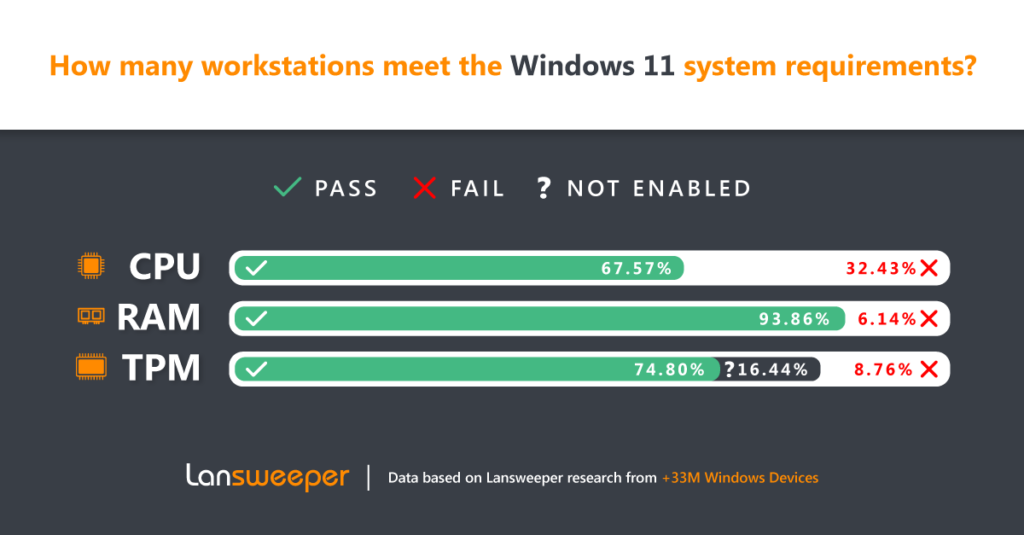
Specifically, only 67.57% of CPUs for workstations tested met the system requirements for upgrading to Windows 11, while 32.43% did not. The majority of machines passed the RAM test (93.86%). However, only about 74.80% of the workstation TPMs tested met the requirements, while just under 9% failed and 16.44% were not TPM compatible or did not have it enabled.
Compared to our original numbers from 2021, these are good signs for Microsoft. The percentage of devices that meet the CPU and TPM requirements has steadily gone up by roughly 10% each year. This can be explained by old Windows end-user devices steadily being replaced by new ones. The percentage of machines meeting the RAM requirement also keeps moving up ever so slightly by 1%. If this growth continues, theoretically all devices should be Windows 11 compatible by 2026. Although this does fall short of the Windows 10 end-of-life on October 14, 2025.
Windows 11 Adoption Rate
Additional Lansweeper data research focused on Windows 11 adoption rates revealed some interesting data. So far, only 8.35% of users have made the jump to Windows 11. However, that does show a growth of 5.74% since our check back in September 2022. This shows that the percentage of Windows 11 users has more than tripled since then. This is the first year we have seen significant growth in Windows 11 adoption.
This has a number of reasons. The most obvious and most impactful one is the fact that new devices come with Windows 11 by default. On top of that, Windows 11 has now had 2 years to mature, making the OS more reliable and the upgrade less risky in the eyes of cautious IT teams.
Finally, most older popular OSs like Windows 7, 8, and XP are now irrevocably out of support. The use of these older systems has steeply declined and old machines are being replaced by Windows 11. Running outdated operating systems like Windows 7 or Windows 8 has its cybersecurity dangers. They no longer receive any bug fixes, security patches, or new functionality. This makes any user – personal or enterprise – significantly more susceptible to malware attacks. The infographic below shows the OS distribution of Windows devices:
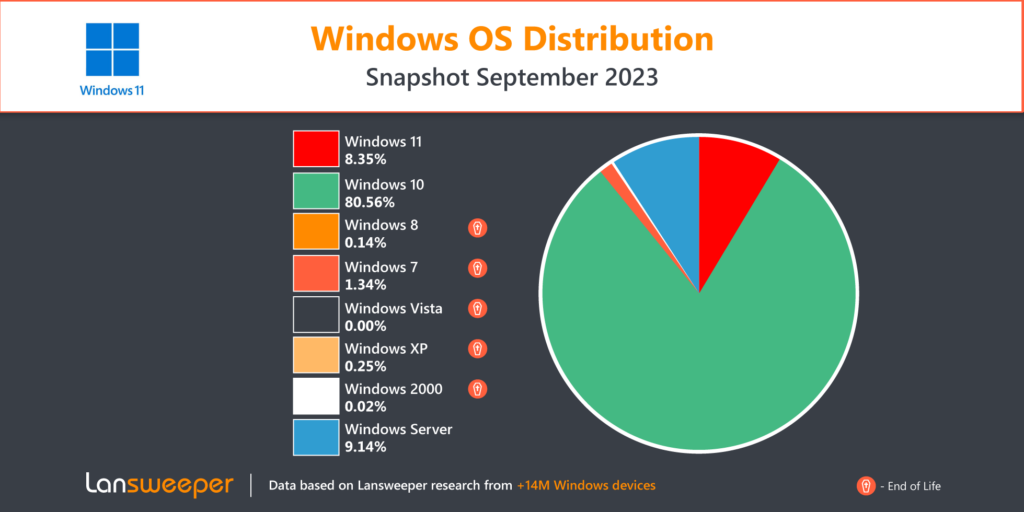
For the moment, Windows 10 (80.56%) remains the most popular OS by a long stretch. Windows 11 adoption has overtaken all the other options with Windows 7 (1.34%) and 8 (0.14%) showing the most decline. Together, Windows 11 and Windows 10 make up 88.91% of installations. Combined with the numbers for Windows Server (9.14%), this means that 98.05% of users are using a supported Windows OS.
In late April 2023, Microsoft confirmed that the current version of Windows 10, 22H2 will be the final version. This means that when 22H2 goes end of life on October 14, 2025, Windows 10 will be fully out of support.
Windows 11 System Requirements
Given these findings, it’s clear that a lot of work still needs to be done to achieve Windows 11 readiness. The new operating system has more stringent system requirements than its predecessor. With modern hardware that improves security and over 1,000 new management controls, older management systems like Group Policy can start fading away.
To install Windows 11, devices must have a 1 GHz processor (or faster) with two or more cores on a 64-bit processor or SoC. They also need 4GB of RAM and at least 64GB of storage. Automatic upgrades to Windows 11 have additional system requirements like secure boot capability and TPM 2.0 enabled which make upgrading even more challenging. Devices that fail to meet these requirements may not receive future updates.
For enterprises with thousands of Windows machines, preparing for the Windows 11 upgrade is a massive task without automation — and even worse without an up-to-date IT asset inventory. It would be impossible to find all the devices using manual, paper-based processes, as many organizations have abandoned IT assets that are sitting idle but are still connected to the network. The reality is, you can’t update machines you don’t know you have.
Microsoft does offer some tips on preparing for a smooth Windows 11 migration and has a PC health check tool intended for assessing the compatibility of PCs with Windows 11. However, without complete visibility across the IT estate, organizations could potentially waste hours and significant budget manually inspecting machines — not to mention the risk of missing outdated machines they don’t know about.
Assess Windows 11 Migration Readiness with Lansweeper
Fortunately, organizations using Lansweeper have access to a breadth of data that Microsoft’s health check tool can’t provide and IT teams can leverage that data to prepare for the Windows 11 rollout. With Lansweeper, IT teams can identify all connected Windows machines with little effort, and gain access to all of the data they need in minutes.
Lansweeper combines market-leading scanning technologies to scour the network and collect detailed information about every connected device. Using agentless deep-scanning technology, it scans all devices, provides granular information about system configurations, software versions, users, and more, and creates a comprehensive IT asset inventory. This makes it easy to pinpoint machines running old software and make a plan of action to either update or retire them.
Lansweeper combines its passive scanning ‘Asset Radar’ technology with Credential-free Device Recognition (CDR) to detect assets the moment they connect to the network. CDR recognizes a machine’s OS during the initial scan, without the need for agents or credentials. Administrators receive results in near real-time — without wasting hours and resources on manual processes. Learn more about Technology Asset Intelligence.
Our experts created a Windows 11 Readiness Audit Report that you can run against the asset inventory to check for machines that are eligible for the Windows 11 upgrade. The report presents all the information in a visual, digestible format, making it easy to create a migration plan.

Having this information on hand will simplify and accelerate the rollout. That way your teams can use their time to focus on upgrading or retiring machines that don’t meet the new requirements, saving significant time and costs. Plus, it will reduce the risk of leaving outdated machines connected to the network.
Don’t wait until it’s too late. Get prepared now!
Windows 11 provides a host of new features and benefits to users, including an improved UI, support for efficient multitasking, better gaming, productivity apps, and more. Still, the transition will certainly strain IT teams as they scramble to update devices before the Windows 10 EOL. Lansweeper customers benefit from rapid access to all the information they need to take action while saving time and resources as they prepare for the organization-wide migration to Windows 11.
Get Started with Lansweeper
Discover assets you don’t even know about and learn why Lansweeper is used by thousands of organizations worldwide.
TRY NOW